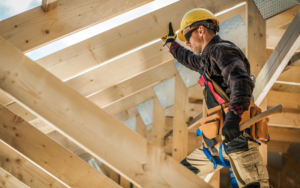Annual Salary: $55,600* 
*Average annual compensation for a craft worker in Wisconsin.
Source: U.S. Department of Labor, Bureau of Labor Statistics, May 2022
DESCRIPTION
Carpenters possess skills and perform work which is basic to most building construction. They erect wood framework in buildings; build forms for concrete; and erect partitions, studs, joints, drywalls, and rafters. Many carpenters work indoors to install all types of floor coverings, ceilings, paneling, trim, and interior systems. They must be very skillful as “finish” work is visible and often involves expensive materials. Some carpenters construct docks and work with large timbers and drive piles to support the foundations of buildings and bridges. Another branch of the trade, called millwrights, installs heavy machinery in industrial plants and turbine generators in power plants. All carpenters use a wide variety of hand and power tools, and they must be able to maintain their tools in good, safe working order.
Working Conditions
Carpenters usually work with or around other construction tradesmen. They work indoors and outdoors and often in tight places. All carpenters have to do considerable climbing, lifting, and carrying to perform their work. They must also be able to do a great deal of reaching, balancing, kneeling, crawling and turning.
Aptitude and Interest
To be a good carpenter a person should enjoy doing precision work, have pride of craftsmanship, the ability to work without close supervision, and be able to adapt to a wide variety of conditions. Manual dexterity and the ability to solve math problems quickly and accurately is necessary for those who wish to become top craftsmen.
Training
To become a skilled carpenter training is essential. It can be acquired informally through “learning-by-working;” through company on-the-job training programs, by attending trade or vocational/technical schools; through unilaterally (management or labor) sponsored trainee programs; through registered labor-management apprenticeship programs, or a combination of the above. It is generally accepted that the more formalized training programs give more comprehensive skills training. Recommended high school courses include algebra, general science, mechanical drawing, English, blueprint reading, and general shop.